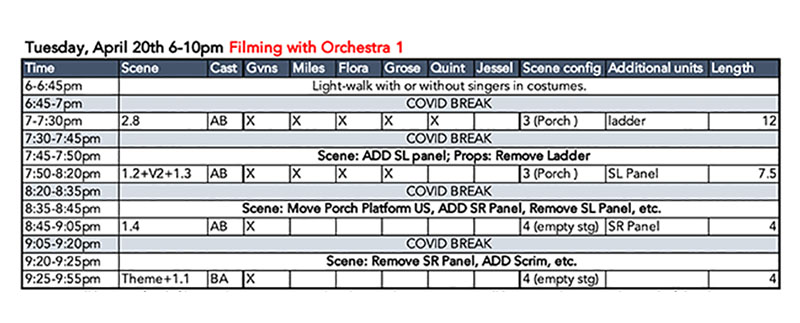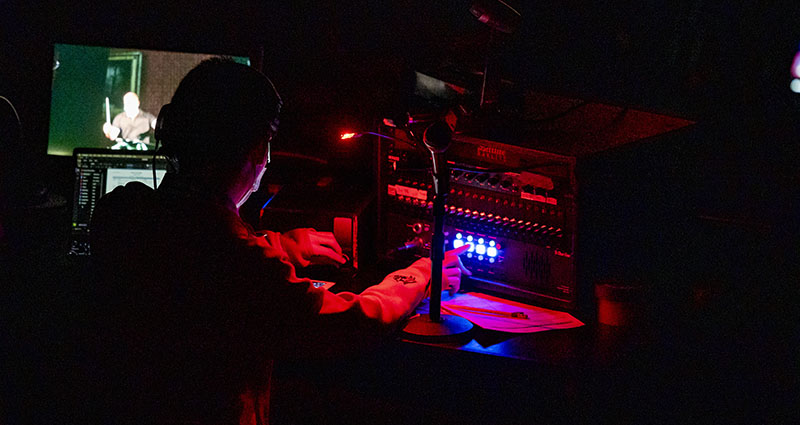Inspired by the ways in which COVID-19 has transformed what it means to learn and work in the performing arts, Performing Your Art in a Pandemic invites C-U performing arts students to share their experiences, be they frustrating, surprising, or inspiring. If you have suggestions, ideas, or feedback, feel free to contact us at [email protected].
This semester I stage-managed the Turn of the Screw, an opera production produced by the Lyric Theatre @ Illinois (LTI). Due to COVID-safety precautions, this opera production is presented to the audience in a filmed format. Although LTI has already experimented with filming last semester, this was the first full opera production with a double cast filmed onstage. In this process, I learned a lot about stage-managing an opera, as well as filiming one during COVID times.
During COVID, the LTI and Krannert Center for the Performing Arts has made a series of rules and guidelines, to guarantee the safety of performers and other production staffs. As stage managers, I and my two assistant stage managers maintained the rules throughout the rehearsal process to create a COVID-safe working environment. One of the biggest changes to our working routine is the “COVID Breaks.” In order for > the air in the space to better circulate, we’re required to clear the space for 15 minutes every 45 minutes of masked rehearsal or 30 minutes of unmasked rehearsal. This was one of the factors that affected our filming schedule: all of our unmasked filming has to be broken down into 30-minute session. Sometimes losing actual working time and interrupting the artists’ creativity can be very frustrating; sometimes I myself must be< highly engaged with everything happening onstage. However, as the timekeeper of the team, I must be constantly aware of the COVID break times and remind the designers and director of them.
Another COVID-related challenge is the social distance in rehearsal. Different than the 6- feet social distance we’re familiar in everyday life, LTI has a 10-feet distance rule for the singers in rehearsal and performing onstage. In order to comply with this rule, the stage director, Dawn Harris and the stage management team worked closely, to create socially distanced blockings. In rehearsal, our assistant stage managers each has a 10- feet long pole at hands to help give singers an idea of the distance.
At first it seemed impossible to stage the opera with everyone so far from each other, especially when characters are supposed to physically interact with each other per the requirement of the plot. During staging rehearsal, Dawn and our singers explored a lot and did an excellent job using creativity to address these problems artistically; for me, the challenge was mainly about balancing discipline and flexibility: how strictly we should stick with the rule, what is the line that should not be crossed, when should I< intervene to say “NO” … This was a process of exercising my own discretion and judgment to in order to support the artists, as well as keeping things on track safely.
At the very beginning of the process, the show was planned to run and be filmed in a normal sequence. But as the design process developed, the director and designers created a variety of scenic looks for different scenes with our existing scenic units. At that moment, we realized we have to film this opera out of order, as the scenic units are too big and difficult to move around within normal scenic change time.
As the stage manager, my first major task was to make a filming schedule, that fits all of the scenes into our 6-day filming week, as well as making convenience for everyone on the team, including costumes, scenery, props, and the vocal condition of our two casts. I grouped the scenes with similar scenic looks and costumes together, to reduce scenic and costumes change time to the minimum; I then added in the changeover time for scenery and major props, to check the feasibility of shifting scenes on time, as well as the two casts arrangement. The final product of the filming schedule includes a lot of details that usually don’t appear in a schedule; however, it was really helpful when we
needed to adjust filming order and rearrange the scenic shift. Eventually, this plan turned out to work really well for our filming.

Image by Tom Zhang
During filming, this sequence also created a dynamic that’s totally different from one with a live performance. Jumping around to different scenes in the opera not only created the
challenge for singers to shift their moods and get into their roles quickly, but also required a different working rhythm for the production team. Each take means a reset for all of the elements, including orchestra, lighting, media, scenery and props, etc. Sometimes we needed to pick up from the middle of a scene, and that requires fast and precise reset for singers and crew. Our assistant stage managers and deck crew did a great job handling the details onstage, and we managed the transitions between takes and scenes very smoothly.
One thing I really enjoyed in this production was experimenting with technologies. Going back to pre-COVID times, stage management in our department has had its own traditional way of doing things: we printed every piece of paperwork to distribute, post, or put in our own production book. But with the restrictions of COVID, many routines were
suddenly changed. We can no longer post paperwork on callboards, to prevent people from gathering in front of them; we try our best to avoid distributing paperwork, to reduce potential virus transmission. As a result, people started to experiment with technologies to find alternative ways of doing things.
The first thing I tried was making a digital production book. A production book is usually a binder where stage managers put their score/script, cues, schedule, reports, notes and all other paperwork into, to assemble a well-rounded “database” of the production. In this opera production, instead of printing a physical book, I used my iPad to read and notate the score, as well as organizing all of my paperwork. It was not only environmental-friendly that I no longer need to print everything for myself, but also very convenient and quick. Without considering how it looks when printed out in black and white, I added colors to most of my paperwork, to make them nice-looking and easier to read. What’s more, in filming when we required absolute quiet, I can flip the pages quickly without worrying about making any noise, which a physical book usually does.
Besides the digital book, our team also developed a cellphone app for our cast, crew and production team. We posted all of our schedules, guidelines, as well as important contact information in the app, to give people a convenient access to the information they need. It served in place of the physical callboards in our hallways and made our life much easier.
COVID has changed a lot of routines in stage management and challenged our definition of many things. As stage managers, we have to be flexible and ready to embrace changes and new possibilities. At the same time, we have to constantly question and rethink: what is really necessary and what can we get rid of. In post-COVID life, we will likely get rid of many these safety rules and go back to “normal,” but there are also many things that have changed forever.








